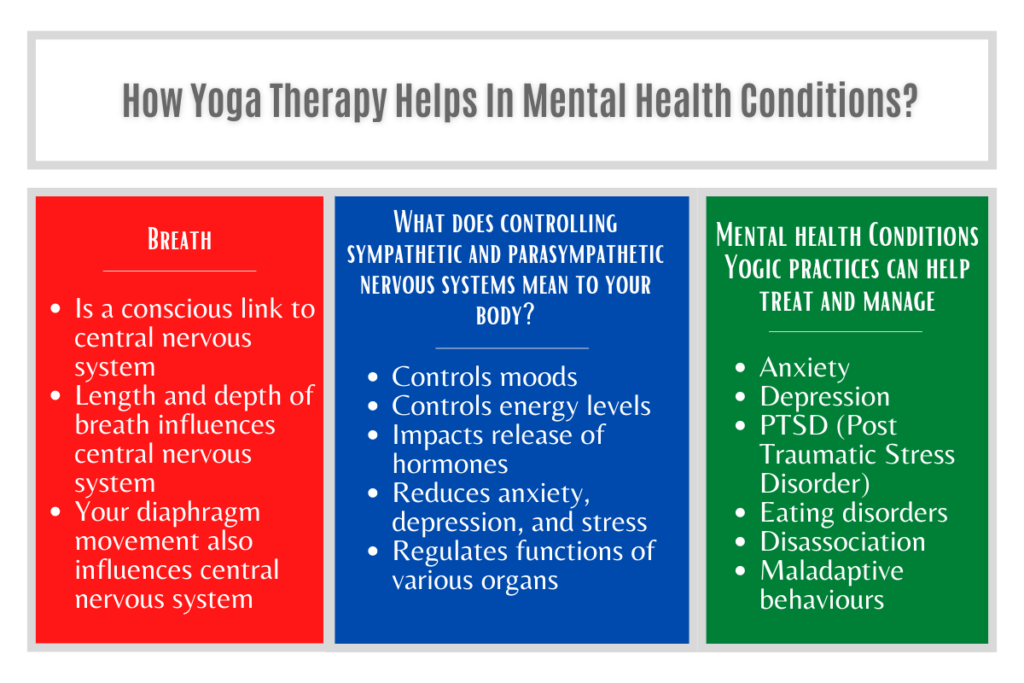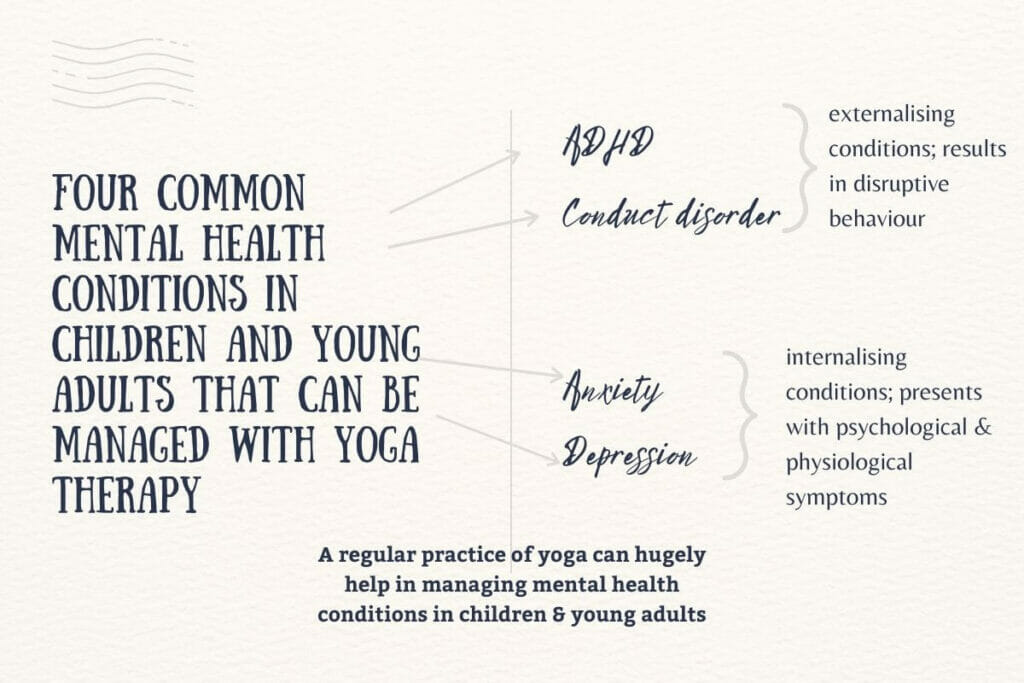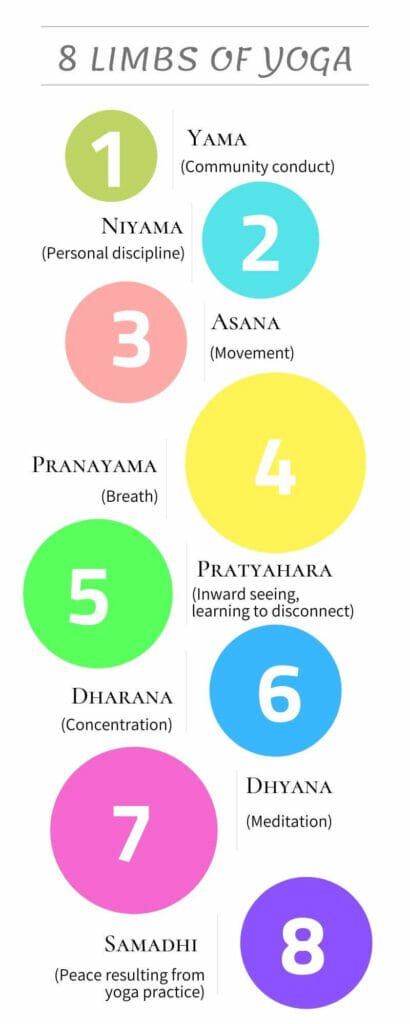The incidence of diseases are on the rise, and so are the costs of medical care. The aim of medical care is to provide relief to the patient, physically and mentally. Sadly, in conditions like cancer and mental health, the symptoms are treated without significant relief to the patient’s attitude towards life and living. This is where therapies are extremely beneficial; yoga therapy is one such that gives you various benefits, including peace, content, and happiness despite ailing health conditions. Perhaps the oldest science of healthy living, yoga has a lot to offer as a therapy. We all have a lot of questions about what yoga therapy can do.
Lura, a well-experienced yoga therapist and teacher with a wealth of knowledge, answers a few questions that we had. We hope her answers would provide an insight into what you can expect from yoga therapy and possibly enjoy the benefits it can provide in case of a need.
Our questions and Lura’s answers…
The most basic – What is yoga therapy?
The International Association of Yoga Therapists defines Yoga Therapy as the process of empowering individuals to progress toward improved health and well-being through the application of the teachings and practices of Yoga.
It really is yoga for the individual that will serve the needs of that person at this time in their lives, helping them progress toward better health. And for me, that should actually be how everyone practices daily, not just those looking for healing but to keep our minds and bodies in balance.
How are yoga therapy sessions different from other yoga sessions?
Modern-day yoga has mostly been reduced to a physical workout, opening hip flexors, lengthening the hamstrings, strengthening the core or buttock. As the popularity of yoga has spread, class times have been cut; and what is removed is the relaxation, the stillness, the time for self-inquiry, and building connections within one’s self.
Yoga therapy is generally individual or a small group with the same health issue so that we can focus on the specific needs of the client, both physically and mentally. We use the most appropriate practice for the issues we are dealing with, and the practices include:
- pranayama – breath, relaxation or stimulation
- asana – movement
- savasana – relaxation
- chanting and mantra – respiration and focus
- mudras – connecting the energetic lines within the body (nadis – think acupuncture meridians)
- Kriyas – shat karmas or cleansing practices
- Dharana and Dhyana – concentration, mindfulness and meditation
Can yoga therapy help deal with chronic ailments such as diabetes?
Yes, modern medical research on yoga considers it a promising, cost-effective option in treating and preventing many chronic issues.
Specifically, with diabetes, multiple medical studies show the effects of specific yogic practices on the disease. Diabetes is a chronic metabolic disease that adversely affects the quality of life.

Psychological stress and negative mood have a bi-directional effect on the control of diabetes. Therefore, reducing stress, thereby lowering cortisol levels, is great for blood sugar management.
Studies found improvement in glycemic control with yoga therapy, which persisted over long periods of time with protection from long-term complications.
Besides, the pranayama practices in clients with moderately elevated blood pressure reduced both systolic and diastolic blood pressure in patients with hypertension. Also, practising asana (movements) significantly decreases the free fatty acids, LDL and VLDL cholesterol, with an increase in HDL cholesterol.
All these changes, reducing free fatty acids, blood pressure and bad cholesterol, suggest improvement in insulin sensitivity following yogic practices. And there were more positive results depending on the length of time one has had diabetes.
Can yoga therapy help in the case of mental health issues?
Yes, pretty much it can.

First, in a yoga class, we focus on the breath. The breath is our conscious link to our central nervous system. The length and depth of our breath and the movement of the diaphragm heavily influences our central nervous system.
Controlling the sympathetic and parasympathetic nervous systems means controlling
- our moods
- energy levels
- the release of hormones
- stress, anxiety and depression
- the functions of several organs
The use of the breath and the asana (movement) provide a place for self-inquiry and a deepening of self-reflection, bringing about more self-realization. Yogic practices are now commonly used to treat anxiety, depression, PTSD, eating disorders, sleep disorders, disassociation, and maladaptive behaviours.
We noticed your work with cancer survivors earlier in your career. Can you explain how yoga therapy helped them?
Yoga can assist in recovery from cancer treatment in several ways.
Pranayama (breath) helps relax the mind and calm the body. Asana (movement) helps in stretching and strengthening the surgical area. Besides, asana helps to prevent and assist in treating lymphedema and neuropathy.
Meditation offers numerous health benefits such as:
- improve immune system function
- increase gastrointestinal tract function
- lower blood pressure, importantly during chemotherapy
- boost working memory and increase cognitive flexibility
- increase the ability to focus and suppress distractions
- enhance self-insight
- decrease reactivity and increase response flexibility
- reduce anxiety and depression symptoms
- reduce emotional reactivity
- decrease rumination (focus on past bad experiences and feelings) via disengagement (discounting and devaluing self)
You have also worked with integrative medical professionals and helped clients with numerous health problems. Can you elaborate more about the role of yoga therapy in this case?
Integrative Medicine is healing-oriented medicine that takes into account the whole person, including all aspects of lifestyle. It emphasizes the therapeutic relationship between practitioner and patient, is informed by scientific evidence, and uses all appropriate therapies both of modern science and traditional wisdom traditions.
So, when a client chooses to opt for integrative medicine, the procedure would be like this.
- The client receives a diagnosis for the disease and wants to do everything possible to overcome the condition with complete healing.
- The doctor would inform team members of the client’s health status and disease and her/his treatment plan recommendation.
- Then the team would respond with each team member’s recommendations and any additional questions.
- The options are put to the client with recommendations, and they would choose the ones they are interested in or felt would be most effective for them.
- The team would then start applying the therapies after meticulous planning.
We know the importance of belief. So the client must have trust in the treatment and its provider for it to be an effective part of the healing process.
Does yoga therapy help children? Have you had any such experiences?
The four most common mental health conditions in youth are attention-deficit hyperactivity disorder (ADHD), anxiety, conduct disorder, and depression. These can be divided into externalizing conditions (ADHD and conduct disorder) which often result in disruptive behaviours, and internalizing conditions (anxiety and depression) that present with psychological and physiological symptoms.

I spent several years at a homeless shelter for 10 -18 year olds as a volunteer yoga teacher. The age (preteens and teens) is a difficult time finding out who you are, especially if there are issues at home or with homelessness. We practised yoga every Saturday afternoon. At first, there was an adverse image of yoga. But I would let them lay down and teach them the 3 part diaphragmatic breath, and the whole world melted; they got softer, relaxed.
The stress these children carry is unimaginable. So much of their daily lives is a struggle that, to have a few minutes of peace, to learn that they all have this power inside of them, to create this space for themselves was so powerful that it changed behaviours and changed lives.
Also, it is important to note, there are other helpful protocols in yoga therapy, such as asana (movements) for scoliosis to help straighten and lengthen the spines of grown children, etc.
Do people with health conditions approach you for therapy directly or get referred to you by medical health professionals?
Both.
Now, living in a rural area, I do get referrals but not as much as when I lived in the city. Integrative doctors, board-certified holistic doctors, reconstructive surgeons, infertility specialists and many nurses referred clients to me. Also, previous clients refer patients to me.
Now I am working in a rural community with teens helping scoliosis, hip and knee replacement, and stroke patients. However, I no longer assist cancer or other internal organ surgeries’ patients. And in my regular yoga classes, I see an immense amount of young adults from around the world with anxiety disorders and depression.
A more generic question, how important is practising yoga? What is a person missing by not practising yoga?
Well, in today’s hustle-bustle world, so many people are high strung, easily irritated, hyperactive, and hyper-driven. And so, in many ways, life is always on edge and out of balance.
I cannot believe the number of young people I meet here each day suffering from anxiety. Yoga practices can help everyone with anxiety, stress, and depression through the breath. Self-inquiry can lead us to evaluate our lives and what we value. We need all of the pieces to this puzzle to stay in balance, build resilience, and keep our own peace. Hopefully, as people practice all of yoga’s 8 limbs, this can be achieved.
The eight limbs of yoga are:
- yama and niyamas (moral precepts)
- asana (movement)
- pranayama (breath)
- pratyahara – inward seeing (learning to disconnect at times)
- dharana – (concentration)
- dhyana – (meditation)
- samadhi – (the peace resulting from practising yoga)
I have forgotten who said it, but here is a great quote, ‘The world today is over-stimulated and undernourished.’ I say yoga provides that nourishment so we can choose what we want and when we want stimulation because much of the stimulus is unnecessary and only distracts us from our true self.
Could you provide comments/feedback/testimonials from your yoga therapy clients?
This work comes from a different realm, and in the U.S., ethical violations in medicine require patient confidentiality. We value privacy.
But I will share one nameless story that I will never forget. I had a mature (55+) woman, a retired teacher and a breast cancer survivor that worked with me for 6 to 7 months during her recovery.
Over the summer, I received a postcard from a small vacation town in our state. It was from this woman thanking me that she had her strength and flexibility back because she so enjoyed tubing with her grandchildren. Tubing is like water skiing. You hold a tow rope while laying on a giant inflatable raft, in her case with a few grandchildren with her. (This requires both upper body and arm strength, exactly what is affected by a mastectomy.)
Such is the power of yoga practice and belief!
What does a private yoga therapy session look like?
We would meet in the studio and have a conversation about what the person is going through, how they are feeling mentally, physically, what’s been altered, what the medical plan is, what that might affect, and what they want to do after treatment, either resume or a new goal to reach in recovery.
Then I would have them stand and do a few easy movements to do a postural analysis. I want to see their habituated structure from their daily life and what is happening in the affected area of the body. After that, I would have them lay on the floor to see how they breathe. And then I give them a few things to do until we meet again.
In a few days to a week, we will meet again.
I will have prepared a very personalized plan (they take weekly home instructions) based on all I learned from them and what I observed in the last meeting.
Typically, a session would last to 90 minutes. We talk about the changes they are going through mentally, emotionally because these are often life-threatening illnesses. We start where they are at, we start with the breath, and then if they are still in treatment, I consider their medications, energy levels etc. Then, over the coming weeks, we meet and review and add to their specific plan.
Generally, I work with a client for 3 – 6 months, sometimes a bit less or more. The goal is to get them comfortable, stronger and back into the flow of life. If they want more than that, we continue to prepare them for a new goal.
Love4wellness concludes,
Yoga therapy can be hugely helpful in improving the quality of life, especially in ailing people. If you are going through a difficult period of ill health, you can consider reaching out to a yoga therapist and discuss options to improve your health and outlook towards life.
Take care!
Edited by love4wellness.com | Images: canva.com

